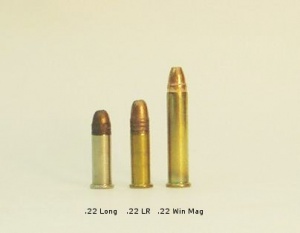.22 Long
| .22 Long | ||||||||||
|---|---|---|---|---|---|---|---|---|---|---|

| ||||||||||
| Type | Rimfire | |||||||||
| Country of Origin | USA | |||||||||
| Specifications | ||||||||||
| Parent Case | .22 Short | |||||||||
| Bullet Ø | .223 in (5.7 mm) | |||||||||
| Neck Ø | .224 in (5.7 mm) | |||||||||
| Base Ø | .225 in (5.7 mm) | |||||||||
| Rim Ø | .272 in (6.9 mm) | |||||||||
| Rim Thickness | .042 in (1.1 mm) | |||||||||
| Case Length | .415 in (10.5 mm) | |||||||||
| Full Length | .798 in (20.3 mm) | |||||||||
| Primer | Rimfire | |||||||||
| Production & Service | ||||||||||
| Production Dates | 1871-present | |||||||||
| Ballistic Performance Sampling | ||||||||||
| ||||||||||
The .22 Long has the same case length as the vastly more popular .22 Long Rifle, but differs in that the Long Rifle has a significantly heavier bullet, a longer overall length (due to the longer bullet used), and a higher muzzle energy. The .22 Long is essentially obsolete; no new firearms are designed specifically to use it, and the largest 3 producers of .22 Long ammunition ceased production (although it continues to be made by CCI, Aguila, and others). Many .22 Long Rifle guns will chamber and fire the shorter round, though the .22 Long generally does not generate sufficient energy to operate semi-automatic guns. The one prominent survivor of the .22 Long is the .22 CB Long, a long-cased version of the .22 CB.
While the original .22 Long loading used the same powder charge as the .22 Long Rifle, and the .22 Long bullet was significantly lighter, the combination does not result in higher velocities for the .22 Long when fired from a rifle. The large barrel volume to chamber volume of a .22 rimfire rifle means that the powder gasses have expanded as far as they can in well before the muzzle of a normal length rifle barrel, and the light .22 Long bullet doesn't have the inertia of the .22 Long Rifle. This means that the .22 Long bullet (and to a lesser extent the .22 Long Rifle, in most loadings) actually slows down significantly before it exits the barrel.
Since the .22 Long Rifle performs as well in a short handgun barrel as the .22 Long does, and outperforms it significantly in a long rifle barrel, the development of the .22 Long Rifle assured the .22 Long's path to obsolescence. In a sense, though, descendants of the .22 Long still live on, though they are not sold as such.
Hypervelocity loadings of the .22 Long Rifle use bullets as light as 30 grains (1.9 g), and special blends of powder to make full use of a rifle barrel to generate velocities far higher than normal loads, and chamber pressures high enough to cycle semi-automatic firearms reliably. The most well known of these is the CCI Stinger, which actually goes so far as to stretch the case length slightly, so that with the short, light bullet, the overall length is still within the max overall length for the .22 Long Rifle.
Specifications
- Length:
- Case: 0.595 in (15.1 mm)
- Overall: 0.880 in (22.4 mm)
- Bullet weight: 29 gr (1.88 g)
See also
References
- ↑ 1.0 1.1 Cartridges of the World 11th Edition, Book by Frank C. Barnes, Edited by Stan Skinner, Gun Digest Books, 2006, ISBN 0-89689-297-2 pp. 490, 492
